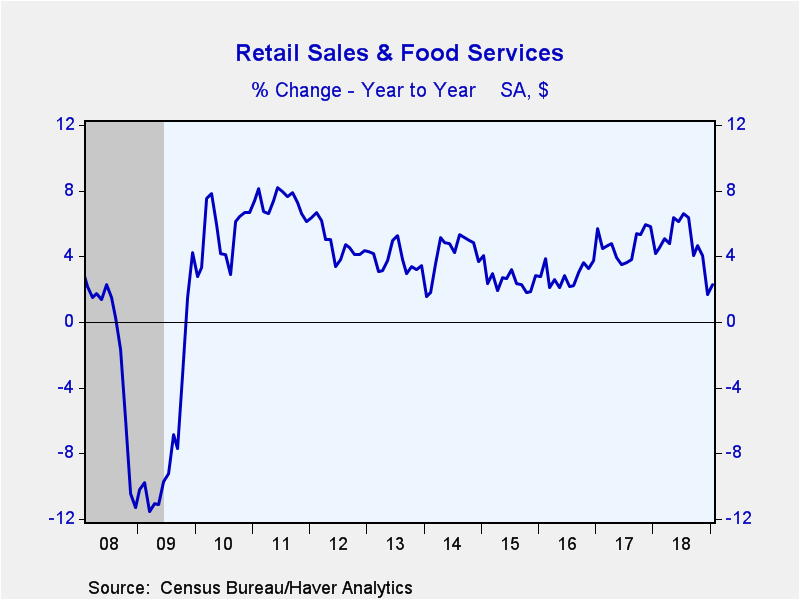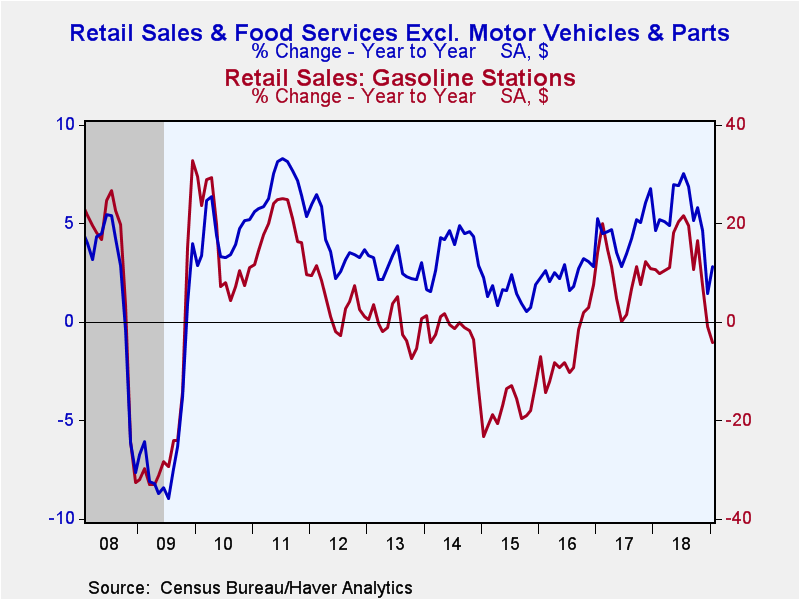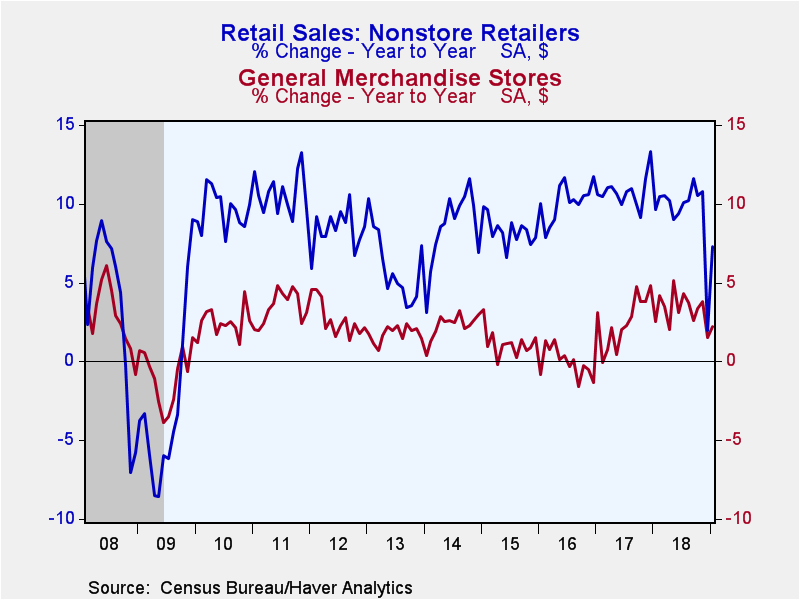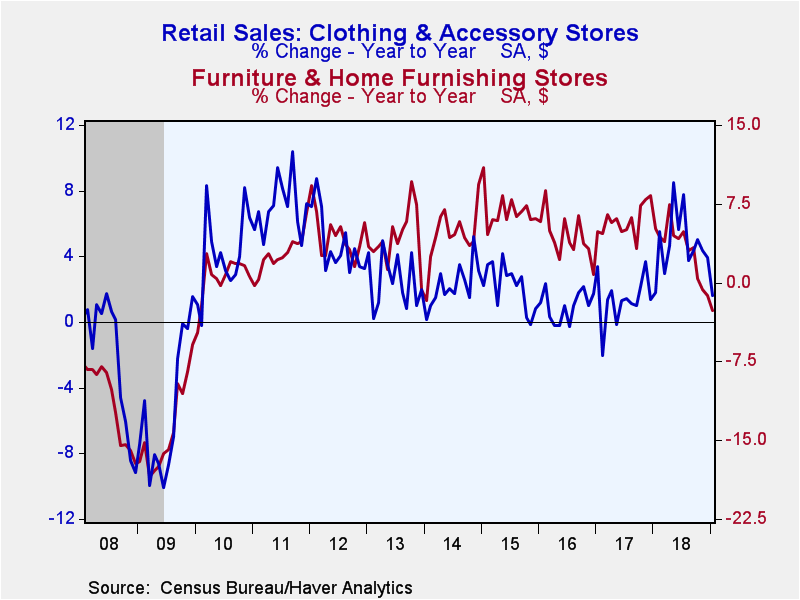 Global| Mar 11 2019
Global| Mar 11 2019U.S. Retail Sales Edge Higher
by:Tom Moeller
|in:Economy in Brief
Summary
Consumers remain in a cautious mood. Total retail sales improved just 0.2% during January (+2.6% y/y) after pulling back spending by 1.6% in December, revised from -1.2%. A 0.1% uptick had been expected in the Action Economics [...]
Consumers remain in a cautious mood. Total retail sales improved just 0.2% during January (+2.6% y/y) after pulling back spending by 1.6% in December, revised from -1.2%. A 0.1% uptick had been expected in the Action Economics Forecast Survey.
Lower sales of motor vehicle sector depressed last months' gain with a 2.4% decline (+0.5% y/y) after two months of 0.3% improvement. As reported earlier, unit sales of motor vehicles fell 4.8% during January. Excluding motor vehicles and parts, retail sales rose 0.9% following a 2.1% drop. A 0.5% rise had been expected.
A measure of the underlying pace of retail spending is nonauto sales growth excluding gasoline and building materials. These sales rebounded 1.1% (2.9% y/y) after a little-revised 1.1% rise.
The improvement in sales last month was led by a 4.8% surge (-6.2% y/y in sporting goods, hobby shop, book & music store sales after falling sharply in each of the prior nine months. Sales of building material stores jumped 3.3% (10.4% y/y) after a 0.5% dip. Online retail sales jumped 2.6% (6.3% y/y), making up half of the prior month's drop. General merchandise store sales improved 0.8% (3.2% y/y) following a 1.5% decline. To the downside were sales of clothing & accessory stores which dropped 1.3% (+2.1% y/y) and repeated December's fall. Furniture & home furnishings stores fell 1.2% (-2.5% y/y), down for the fourth straight month. Sales at electronics and appliance stores eased 0.3% (-3.2% y/y) and have been lackluster for seven straight months.
Reflecting lower prices, gasoline service station sales declined 2.0% (-3.8% y/y) after weakening in three of the prior four months.
Sales of nondiscretionary items improved last month as health & personal care product store sales recovered 1.6% (2.4% y/y) after a 3.3% decline. Food & beverage store sales rebounded 1.1% (4.0% y/y) following a 0.3% easing.
Restaurant & drinking establishment sales recovered 0.7% (5.7% y/y) after a 0.1% uptick.
The retail sales data can be found in Haver's USECON database. The Action Economics forecast is in the AS1REPNA database.
| Retail Spending (% chg) | Jan | Dec | Nov | Jan Y/Y | 2018 | 2017 | 2016 |
|---|---|---|---|---|---|---|---|
| Total Retail Sales & Food Services | 0.2 | -1.6 | -0.0 | 2.6 | 4.9 | 4.3 | 3.1 |
| Excluding Autos | 0.9 | -2.1 | -0.1 | 3.2 | 5.4 | 4.3 | 2.7 |
| Retail Sales | 0.2 | -1.8 | 0.0 | 2.7 | 4.8 | 4.5 | 2.8 |
| Motor Vehicle & Parts | -2.4 | 0.3 | 0.3 | 0.5 | 2.9 | 4.3 | 4.6 |
| Retail Less Autos | 0.9 | -2.5 | -0.0 | 2.7 | 5.3 | 4.5 | 2.2 |
| Gasoline Stations | -2.0 | -5.7 | -4.2 | -3.8 | 13.0 | 8.8 | -5.7 |
| Food Service & Drinking Places Sales | 0.7 | 0.1 | -0.4 | 5.7 | 6.0 | 2.7 | 5.6 |
Tom Moeller
AuthorMore in Author Profile »Prior to joining Haver Analytics in 2000, Mr. Moeller worked as the Economist at Chancellor Capital Management from 1985 to 1999. There, he developed comprehensive economic forecasts and interpreted economic data for equity and fixed income portfolio managers. Also at Chancellor, Mr. Moeller worked as an equity analyst and was responsible for researching and rating companies in the economically sensitive automobile and housing industries for investment in Chancellor’s equity portfolio. Prior to joining Chancellor, Mr. Moeller was an Economist at Citibank from 1979 to 1984. He also analyzed pricing behavior in the metals industry for the Council on Wage and Price Stability in Washington, D.C. In 1999, Mr. Moeller received the award for most accurate forecast from the Forecasters' Club of New York. From 1990 to 1992 he was President of the New York Association for Business Economists. Mr. Moeller earned an M.B.A. in Finance from Fordham University, where he graduated in 1987. He holds a Bachelor of Arts in Economics from George Washington University.










